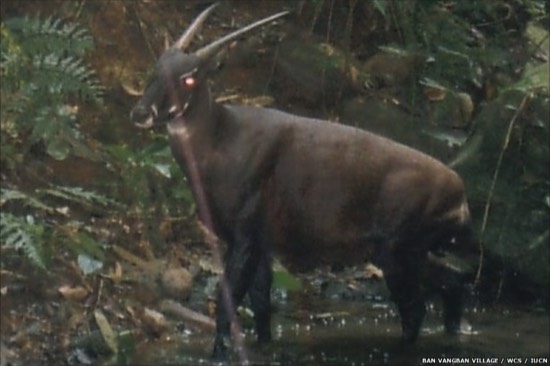The saola, Vu Quang ox or Asian unicorn, also, infrequently, Vu Quang bovid (Pseudoryx nghetinhensis), is one of the world's rarest mammals, a forest-dwelling bovine found only in the Annamite Range of Vietnam and Laos. Cousin to cattle, goats, and antelopes,[2][3] the species was defined following a discovery of remains in 1992 in Vũ Quang Nature Reserve by a joint survey of the Ministry of Forestry and the World Wide Fund for Nature.[4] The team found three skulls with unusual, long, straight horns kept in hunters' houses. In their article, the team proposed "a three month survey to observe the living animal", but more than 20 years later, still no sighting of a saola in the wild had been reported by a scientist. However, a living saola was photographed in the wild in September 2013 by a camera trap set by the World Wide Fund for Nature and the Vietnamese government’s Forest Protection Department. Van Ngoc Thinh, the WWF's Vietnam country director, said, "This is a breathtaking discovery and renews hope for the recovery of the species."[5][6]
In late August 2010, a saola was captured by villagers in Laos, but died in captivity before government conservationists could arrange for it to be released back into the wild. The carcass is being studied with the hope that it will advance scientific understanding of the saola.[7][8] Sometimes, these animals get caught in snares that have been set to catch animals such as wild boar, sambar, and muntjac deer that come to feed on the crops the farmers have planted. This has become a problem, especially with the illegal fur trade, for medicines, restaurants, and food markets.[9] More than 26,651 snares have been removed from habitats where the saola has lived for years.[10]
